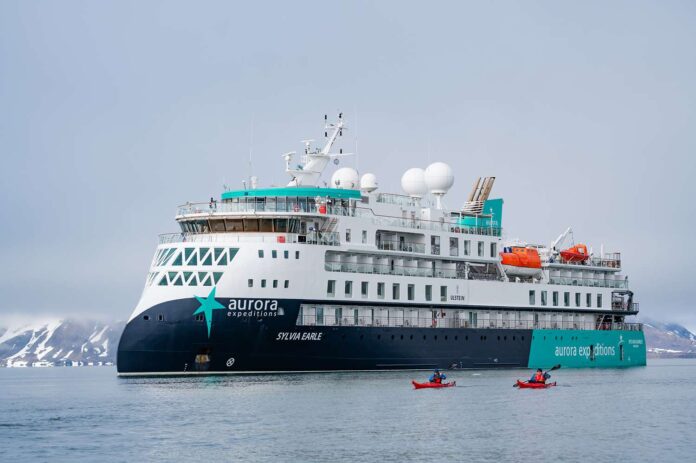:max_bytes(150000):strip_icc():format(jpeg)/TAL-header-kayakers-sylvia-earle-svalbard-SVALBARDCRUISE0724-366d2c6a7b214d6396fbcee2cf7d8370.jpg)
On day two of my trip to the high Arctic, I sat in a kayak alongside Lilliehöökbreen, one of the longest glaciers in Svalbard, at nearly 14 miles. I was watching the glassy water when I noticed something round and steely gray pop out and quickly go back under. At first, I thought it was a rock, but the water was still and reflective — no waves to be seen that could have covered it up or moved my very steady kayak. Suddenly, it jumped up again, and I found myself staring right into the eyes of a curious ringed seal. The other kayakers and I sat silently while the seal bobbed and swam around us, checking out who we were and what we were doing in its habitat. After a few minutes, it lost interest in us and swam away to a ridge of ice in the distance.
Lina Stock /Courtesy of Divergent Travelers
The chance to come face-to-face with this adorable seal was all thanks to an Aurora Expeditions cruise. I was on the Sylvia Earle following the Svalbard in Depth itinerary, a 15-day trip that circumnavigates the Norwegian high Arctic archipelago in an attempt to spot whales, seals, and walruses, as well as to disembark onto pack ice and land in one of the most remote places on Earth.
“Svalbard is a magical place,” says expedition leader Howard Whelan, who was also the founding editor of Australian Geographic. “It’s beyond comprehension. It’s got a subtlety that takes a little while to seep in, but everyone is affected by it. The fact that we’re operating up here in this environment is exciting, as it’s something most people don’t get to experience in their normal lives.”
Richard I’Anson/Courtesy of Aurora Expeditions
Well, unless your daily life involves seeing polar bear cubs wrestle on the low-sloping side of a mountain, or observing eight walruses snuggling in a pile to keep warm on drift ice. When I wasn’t watching seals from the kayak, I was with the other passengers, either attending science presentations or taking Zodiac cruises to observe wildlife (or watching from the ship at a safe distance from the bears).
Bartosz Strozynski/Courtesy of Aurora Expeditions
The Sylvia Earle was a comfortable home base. It’s eight decks high and holds only 132 passengers, so I never felt crowded or overwhelmed with the amount of people around me. There are two restaurants, two bars, a 24-hour gym, two hot tubs, a saltwater pool, a library, a science center, a lecture hall, and a mud room where you can store all your wet items like expedition jackets and waterproof pants in your own locker. It’s one of Aurora’s newest ships, built in 2022, so it takes advantage of the latest technology for its passenger boats: The Earle is constructed with an X-bow design, which slices through the water and ice, and pushes it to the sides rather down to avoid making the front of the ship bounce. This design allows for less noise, which is better for wildlife, plus it’s ideal for fuel efficiency and smoother motion through the water.
And that’s a good thing because the weather can change on a dime in the high Arctic. On one excursion — a landing on snow-domed Kvitøya (the island where Swedish explorer Salomon August Andrée and his balloon-exploration crew perished in 1897) — fog rolled in the moment we stepped on land. It was a quick visit, running through snow up to Andrée’s historical monument and then right back to the Zodiacs. By the time we reached the island’s shore again, the Sylvia Earle was completely invisible in the thick fog. Luckily, the X-bow and extendable stabilizers kept us comfortable, free from the rocky seas outside once we got back on the ship.
Courtesy of Aurora Expeditions
All of the passengers spent some time that day thinking about the speed with which things change in the Arctic, and the absolute danger that awaited the explorers of yore. We were all there to see a new part of the world, but we were safe on a ship, not trekking across floating ice that inexplicably moves you further back the way you came as you plod forward. The Arctic is beautiful, but it can also be moody and cruel.
Lina Stock/Courtesy of Divergent Travelers
Later in the trip, we piled into the kayaks again — this time to paddle alongside the Alkefjellet bird cliffs, where Brunich’s guillemots nest in the thousands. The current was strong, so we didn’t need to do much other than drift along. The birds swooped and soared, flying at eye level past the kayaks and swinging back up toward the sky as they scoped us out. The scene was ethereal, like being in the middle of a starling’s murmuration.
And then, with a beat of a guillemot’s wing, the weather turned and we began to kayak through a windy squall. As we pushed forward, snow and spray stinging our faces from the increasing waves, I finally came to understand historic polar explorers like Andrée on a new level. The draw of the Arctic isn’t just the polar bears and walruses. It’s the lust for exploration, to experience the world in all its colors and shapes, to face down an incoming squall and emerge, knowing you’ve accomplished something so few will ever do.
From now until Sept. 30, 2024, travelers with Aurora Expeditions can book with up to 20 percent savings on Arctic and Antarctic itineraries in 2025, plus an air credit of $2,000 for all Antarctica sailings in 2024 and 2025 or $1,500 for all arctic sailings in 2025.



